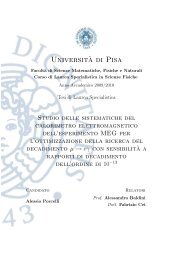Metodi di calibrazione e ricostruzione degli eventi nell ... - MEG
Metodi di calibrazione e ricostruzione degli eventi nell ... - MEG
Metodi di calibrazione e ricostruzione degli eventi nell ... - MEG
You also want an ePaper? Increase the reach of your titles
YUMPU automatically turns print PDFs into web optimized ePapers that Google loves.
In<strong>di</strong>ce<br />
Introduzione iii<br />
1 Motivazioni teoriche e fenomenologia del deca<strong>di</strong>mento µ + → e + γ 1<br />
1.1 Il Modello Standard Minimale . . . . . . . . . . . . . . . . . . . . . . . . . . . . 1<br />
1.1.1 Interazione del muone nel Modello Standard Minimale . . . . . . . . . . 5<br />
1.2 Oscillazione dei neutrini . . . . . . . . . . . . . . . . . . . . . . . . . . . . . . . 6<br />
1.3 Unificazione e Supersimmetria . . . . . . . . . . . . . . . . . . . . . . . . . . . . 9<br />
1.4 Il deca<strong>di</strong>mento µ + → e + γ . . . . . . . . . . . . . . . . . . . . . . . . . . . . . . 14<br />
1.4.1 Stato della ricerca del deca<strong>di</strong>mento µ + → e + γ . . . . . . . . . . . . . . . 14<br />
1.4.2 Segnatura del deca<strong>di</strong>mento e fon<strong>di</strong> . . . . . . . . . . . . . . . . . . . . . 15<br />
1.4.3 La sensibilità sul singolo evento dell’esperimento <strong>MEG</strong> . . . . . . . . . . 18<br />
1.4.4 Cenno alla strategia <strong>di</strong> analisi <strong>degli</strong> <strong>eventi</strong>: la “Likelihood Analysis” . . 21<br />
2 L’apparato sperimentale 25<br />
2.1 Fascio e Bersaglio . . . . . . . . . . . . . . . . . . . . . . . . . . . . . . . . . . . 26<br />
2.2 Rivelazione del Positrone . . . . . . . . . . . . . . . . . . . . . . . . . . . . . . 29<br />
2.2.1 Lo spettrometro magnetico . . . . . . . . . . . . . . . . . . . . . . . . . 29<br />
2.2.2 Il “Timing Counter” . . . . . . . . . . . . . . . . . . . . . . . . . . . . . 32<br />
2.3 Rivelazione del fotone: il calorimetro a Xenon Liquido . . . . . . . . . . . . . . 34<br />
2.3.1 Proprietà dello Xenon come mezzo scintillante . . . . . . . . . . . . . . 35<br />
2.3.2 Struttura, geometria e prestazioni del rivelatore . . . . . . . . . . . . . . 36<br />
2.3.3 Il “Large Prototype” . . . . . . . . . . . . . . . . . . . . . . . . . . . . . 37<br />
2.4 Il sistema <strong>di</strong> trigger . . . . . . . . . . . . . . . . . . . . . . . . . . . . . . . . . . 38<br />
2.5 L’elettronica <strong>di</strong> Front-End ed il sistema <strong>di</strong> acquisizione dati . . . . . . . . . . . 41<br />
2.5.1 Il chip Domino Ring Sampling . . . . . . . . . . . . . . . . . . . . . . . 41<br />
2.5.2 Il sistema <strong>di</strong> acquisizione . . . . . . . . . . . . . . . . . . . . . . . . . . 43<br />
2.5.3 L’offline computing . . . . . . . . . . . . . . . . . . . . . . . . . . . . . . 44<br />
3 Organizzazione del software dell’esperimento <strong>MEG</strong> 45<br />
3.1 Il Montecarlo: <strong>MEG</strong>MC . . . . . . . . . . . . . . . . . . . . . . . . . . . . . . . 46<br />
3.2 L’ambiente ROME e la struttura dell’elaborazione ed analisi dei dati . . . . . . 47<br />
3.2.1 Il <strong>MEG</strong>Bartender . . . . . . . . . . . . . . . . . . . . . . . . . . . . . . . 49<br />
3.2.2 Il <strong>MEG</strong>Analyzer . . . . . . . . . . . . . . . . . . . . . . . . . . . . . . . 50<br />
3.2.3 Il monitor ARGUS . . . . . . . . . . . . . . . . . . . . . . . . . . . . . . 51



